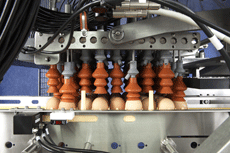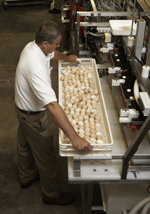UK poultry farmers could soon benefit from in ovo vaccination

Use of in ovo vaccination – now delivering Marek’s disease vaccine to about 85% of US broilers – is likely to expand considerably in the UK and other European countries as new approved vaccines become available.
Much of the poultry vaccine in the UK is delivered post-hatch using a variety of methods, depending on the vaccine type. These include via drinking water, by spray, eye drop or injection. But all these involve a human element in delivering vaccine to each bird. The result is that some birds in a flock can miss out on a full dose.
One way round this is with automatic egg injection, such as with the Embrex Inovoject System, where vaccines are delivered in a precise, uniform way to every egg, every time.
The system punches a tiny hole in the eggshell and then lowers a needle through it to deliver the vaccine to the embryo. This usually occurs on day 18 of the bird’s 21-day incubation period.

Within the UK, in ovo vaccination is not as widely used as in many other European countries, largely due to the poultrymeat industry not widely vaccinating against Marek’s disease. But this is changing as slower growing breeds, such as those used for free-range and organic chicken, are normally vaccinated against Marek’s and this sector of the market is expanding rapidly to meet demand.
In the UK egg sector, day-old chicks are routinely vaccinated against Marek’s in the hatchery. But, as only females are required, this would effectively double the cost of in ovo treatment. This has not prevented in ovo vaccination being used by primary breeding companies in the UK, who value its precision and reliability.
“As the poultry industry develops and brings new in ovo vaccines to the market, we expect its use within the UK to grow considerably,” says William Symington, group director for Pfizer Poultry Health Division’s commercial operations in Europe, Africa and the Middle East.
“The technology will bring real benefits to the European industry, providing a more effective way to vaccinate. By inoculating chicks while they are still in the egg, poultry diseases can be prevented with a process that improves both consistency and reliability.”
The technique provides a range of benefits. Earlier exposure to vaccines can reduce disease resistance and promote early chick health. Dosing is accurate and uniform. Inoculating eggs before they hatch reduces chick stress and handling associated with post-hatch manual injection. Needles are individually sanitised after each injection, minimising contamination concerns.
The system automatically injects and transfers eggs from incubation flats to hatching baskets at up to 70,000 eggs an hour, reducing labour costs, as fewer operators are needed compared with manual vaccination.
Worldwide, more than 600 systems are being used in over 30 countries. The largest use is in the USA, where the technique delivers Marek’s vaccine to about 150m broilers a week.

So what does the future hold in the UK? One way is by looking at developments overseas. The Gumboro (infectious bursal disease) vaccine Bursaplex is the first antigen antibody complex product developed to prevent and control the disease.
“The vaccine is capable of protecting against even highly pathogenic field challenges,” says Vivian Doelling, head of infectious diseases research at Pfizer Poultry Health Division.
The combination of active antigen and specific antiserum in Bursaplex works with high levels of maternal antibody to afford full protection from a single in ovo vaccination. It is licensed in more than 25 countries and primarily used in key Asian and South American markets.
Another introduction by Pfizer to the US later this year is Inovocox, a live oocyst containing vaccine for preventing coccidiosis, which could replace feed additives commonly used to control it.
Increasingly, vaccines from other companies are being approved for in ovo use, such as the combined Gumboro and Marek’s disease vaccine (Vaxxitek HVT + IBD) from Merial Animal Health. It was launched initially in Brazil in 2006 as the first single-dose vaccine specifically developed to protect against Marek’s HVT disease and all known types of classical, variant and virulent Gumboro for the whole life of the chicken.
Helen Houghton, UK avian veterinary services manager of Merial, believes the combination of the benefits of in ovo vaccination with the performance of Vaxxitek makes it economically attractive for standard broiler production. She also points to its ability as a “marker vaccine” to confirm protection from blood sample testing.
One other approved for in ovo use is Cevac Transmune IBD. This single-dose live vaccine contains the Winterfield 2512 strain of the Gumboro virus.
